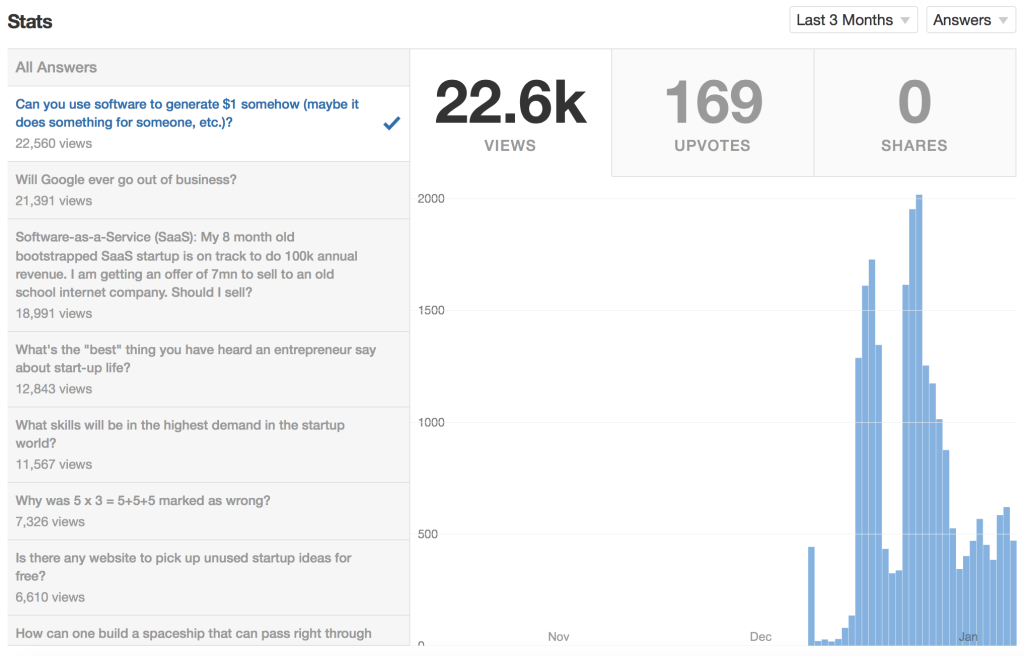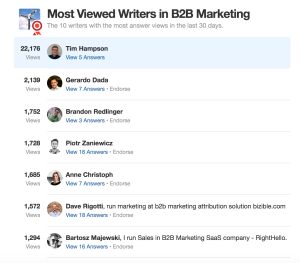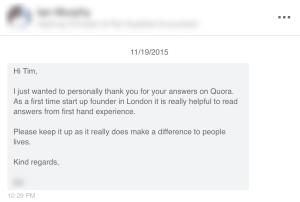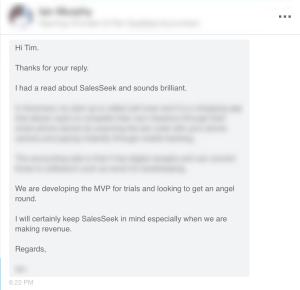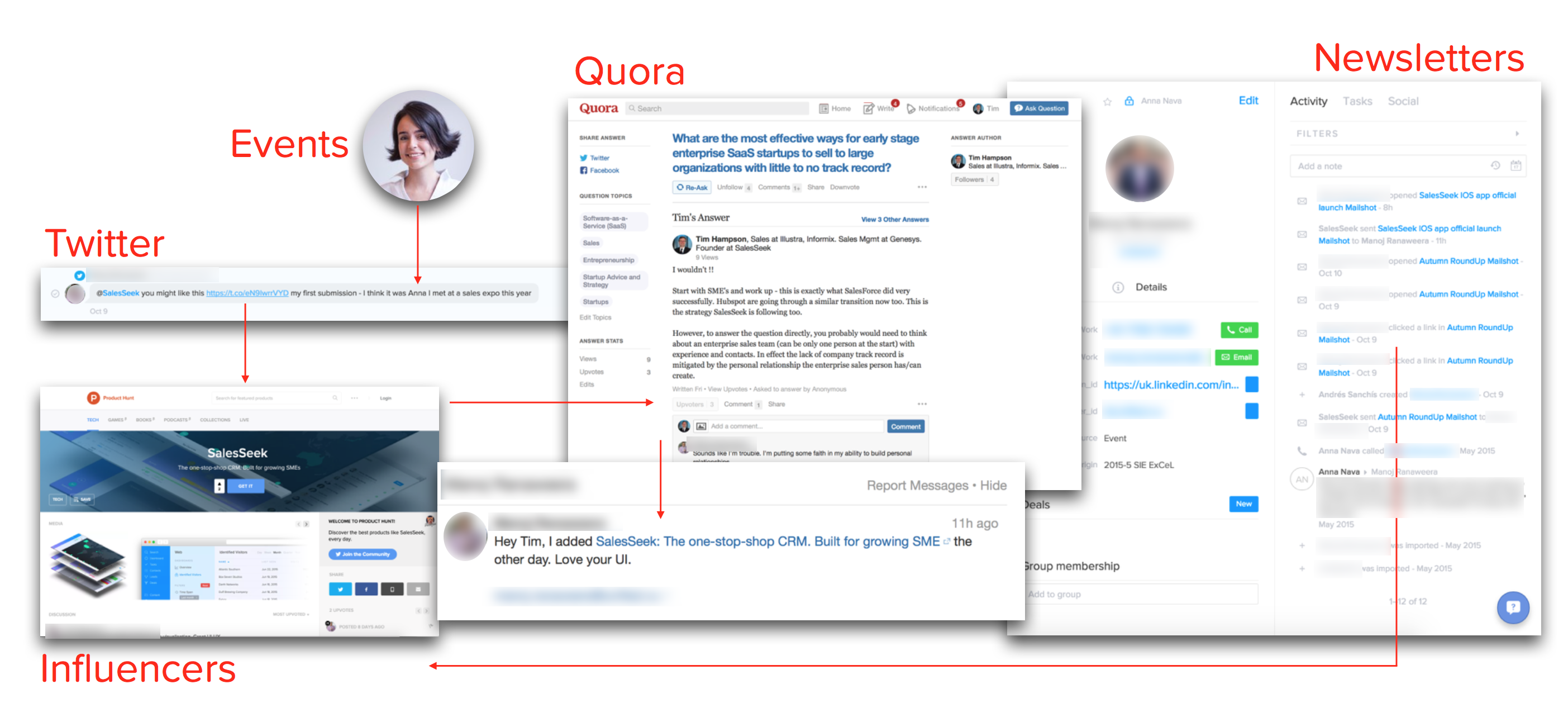Quora was started in 2010 by a couple of Facebook alumni, and over the past 5 years has carved at a niche for itself with high quality questions and answers. All Quora questions are tagged according to topic, and the span of Quora is universal.
There is active interest in most areas, including B2B, startups, sales and marketing (all key areas for SalesSeek). More generally you’ll also see lots of Q&A on current affairs and general life experience. Both President Obama and Hilary Clinton have answered questions on the site. The site is moderated both algorithmically and also by hand to some extent. The moderation works well and the site has a reputation for quality Q&A.
So how can B2B Marketers make use of Quora?
By using Quora as a channel to disseminate expertise. All content is asked and answered by real people, so it’s a great way to showcase your company’s individuals. The “brand” being built up here is primarily a personal one, but assuming that as an individual you are tightly bound to your company, then the company benefits from exposure too. This is what we’ve learned at SalesSeek on using Quora:
Profiles and Bios
Quora is unusual in that you have not just a main profile, but also a series of bios – one per topic. These should not only demonstrate knowledge of the topic area, but also a tie-in to your promoted business. Since bio’s are limited in length in can be challenging to fit everything in, so brevity is a must.
Here is my bio for Startups:
Illustra ($400M acq), Interwoven ($1B IPO), BV, Sakkam, SalesSeek (private)
Clearly SalesSeek is relevant in this case naturally, and the successful exits build credibility.
Here is my bio for Teaching Mathematics:
PhD Theoretical Physics, Subs teacher for Maths/Physics, SalesSeek Founder
Whilst SalesSeek is irrelevant, it’s fundamentally what I’m selling here, so it’s worth putting in. This serves two purposes, first it reinforces “Tim who? the SalesSeek guy”. Second, some finite percentage of people reading answers on Teaching Mathematics will be potential prospects for SalesSeek.
Following Topics and People
Find and follow topics of interest. You can also follow people, but to start, it probably makes sense to focus in on your topic areas. In choosing topics, don’t be restricted to purely business topics. It’s fun (and potentially useful) to also engage on more general areas including outside interests.
I follow what I call a T-shaped approach to topics – answering 1-2 questions across a broad range of topics (in my case things like “life in SF”, “careers advice”, even “physics of everyday life”), but reserving most of my activity for specific niches (in my case primarily “startups” and “SaaS”). The idea of the T-shape is to catch occasional viewers by serendipity, but concentrate on the more relevant viewers.
In terms of my top questions for views, out of the top ten, 5 are about general startup advice, 2 are about Physics/Maths, 1 is about general tech, 1 about Marketing, and 1 about SaaS M&A.
Votes and Views
Vote up questions you think are useful. It costs you nothing, so spread the wealth. It’s worth even upvoting like minded answers “in competition” to your own. It helps to improve the overall quality of the site, and in most cases the recipient will reciprocate and upvote you too. Generally there does seem to be a good correlation between number of upvotes and the quality of the answer. Only in a small number of questions from what I’ve seen is the highest voted answer not as good as the lower voted one. And of course you might argue that’s simply because I’m wrong in my assessment!
Quora frequently promotes answers, and you can often see a clear bump in stats. Here I show a screenshot from my own answer to “can you use software to generate $1 somehow” which was promoted within the Quora digest a couple of times as you can see from the bumps.
Quora provides badges for “top writers”. This means being a top 10 writer in terms of views over the past 30 day period. As such the rankings are always changing.
In addition there are also endorsements where viewers can actively endorse your expertise.
Another element of Quora is that they also work with external media outlets to publish questions and answers of topical interest. Again, this is a reason to maintain a T-shaped approach to answering questions.
Choosing and answering questions
In terms of answering questions, it’s good to initially be guided by serendipity to get a feel for the platform. If your goal is to build up a profile, then it makes sense to start selecting your topics, according to relevance to your company, big enough to reach a large number of people, but small enough to be able to crawl high in the rankings.
Quora frowns upon short snappy answers, even if the question format merits that. Short answers can be “collapsed” – effectively made invisible – if the Quora algorithms consider the answer too short. Other reasons for collapse include downvotes, which typically only happen with frivolous answers. Overall the system works well with a bias to excluding all “poor” content, even if that catches out some good content too.
The usual rules for business writing apply in Quora as elsewhere. One thing worth concentrating on is to try to get inside the head of the questioner. This can be non-trivial for 2 reasons. First, the questioner is coming from a place of relative ignorance, so you need to pitch your answer at what you think their assumed level of knowledge is. One example of this was the question “what is the difference between SaaS (Software as a Service) and BaaS (Backend as a Service)”. Some answered this question tersely (since the clue is in the name). Instead I chose to write a more discursive answer about what SaaS is, why it is valuable, and why those value points have led to the emergence of BaaS. In essence I am assuming the person was asking not “what is the difference”, but “what are”. The second reason this can be difficult is that many questions come from non-native English speakers and I see some answers that over-analyse nuance into questions that may never have been there in the first place.
Since Quora pushes you into more discursive and longer answers, it makes sense to pay attention to formatting and layout. The structure of a Quora answer is to display the first few lines with a “read more” ellipsis. So those first few lines should “catch” the reader and entice them to read the whole answer – that’s how you get the views.
It’s worth taking advantage of the somewhat limited options for formatting by using
- paragraph breaks
- bulleted lists
- bold
in order to create scannable content.
As always, adding images always helps.
Asking questions
Quora can of course be used as a way to gain information. Quora also always and even encourages asking questions that you yourself subsequently answer. You can set your own up. The idea is that this adds to the body of knowledge. If the question is a good one, it will get more views. If your answer is a good one, then it will get more views and votes. If your answer can be improved, it will be. Everyone wins.
Blogs
Quora has recently introduced a blogging platform, broadly equivalent in functionality to the LinkedIn Pulse platform.
I added an old blog posting to Quroa, LinkedIn and Medium about Women in Technology. This is my “test” blog I use to evaluate different platforms, given its balance of general appeal versus specific relevance to SalesSeek. These were the results as of last year:
LinkedIn 12 months 141 views 13 interactions
Medium 7 months 7 views 0 interactions
Quora 1 month 1206 views 5 interactions
Medium views are so bad I am tempted to think I must be doing something wrong. Also, even searching explicitly on the title name it does not produce a page hit for medium, whilst Linkedin comes up top of first page, and Quora top of second page. Putting the title in quotes only picks up this article on LinkedIn and Quora. Again Medium doesn’t show.
I think one reason is Medium does no promotion to speak of. They make a point of saying you should use Twitter etc to promote. They only produce a single daily digest. Conversely LinkedIn publishes a personalised weekly roundup to your connections, and Quora (looking at the bump in stats after 4 days) clearly added my blog to some digests it sent out. I think the fact that both Quora and LinkedIn have network connections make it easier to promote content with those networks rather than to the whole world.
Beautiful as the Medium graphical layout is, fundamentally I am looking at a third party blog platform to deliver a readership. On that basis, Quora wins hands down for me, even if the UI is straight from 1995.
Jason M. Lemkin posted an interesting overview of his own experiences which would seem to echo some of this –
“The largest channels for SaaStr content distribution are www.saastr.com and Quora. We’ve tried Medium. Doesn’t seem to work at all, at least not today. We’ve tried LinkedIn. LinkedIn posts get ~1,500 views on average, which is a rather small compared to what others channels. “
Measuring results
Views and votes are ultimately vanity metrics, although this can be said of all content marketing measures. What counts is leads revenue. It’s too early for my to draw any conclusions here from our own use of Quora over such a short period, but I’ve certainly seen a significant number of Quorans connect to me on LinkedIn:
One important aspect in measuring the effectiveness of any marketing campaign, is that no marketing activity works in isolation. The whole idea of allocating a solitary lead source is seldom how leads really work in practice. Here is a nice example of that idea in practice:
Incidentally, only SalesSeek can give you this 360 degree view of email marketing, social media, and sales interactions in one place.
Like all content marketing, results in large extent depend upon the time put in. Like all social networks, it’s possible to lose track on time and spend half the day there. It’s important to keep a sense of perspective and monitor time so that you always have a handle on the cost/benefit. It makes sense to set yourself a goal/limit of answering a certain number of questions per week and sticking to that schedule and time commitment.
Conclusions
It’s still relatively early days for Quora. The advantage for B2B marketers is that as a young platform it’s easier to gain traction and reputation as a domain expert. The Q&A format works well as it essentially provides the readership automatically. As fantastic as I think my own blogs are in choice of subject matter, they represent only what I think is important. Quora questions represent what the world thinks is important. It’s a great way to generate content elements that can be reused in other contexts too.
Any content marketing strategy worth its salt needs to take Quora into account.

